Are you seeking ISO/IEC 17025 accreditation? Do you struggle with estimating measurement uncertainty? Then, this course is for you. You will learn how to estimate uncertainty in measurement from start to finish through a series of 14 lectures that will show you how to estimate uncertainty step-by-step. Plus, you will learn the skills needed to get ISO/IEC 17025 accreditation that are not taught in other measurement uncertainty training courses. In the beginning, you will learn how to develop your uncertainty analysis: Next, you will learn how to use the GUM method for estimating uncertainty: Finally, you will learn additional skills needed for ISO/IEC 17025 accreditation; This is the most comprehensive measurement uncertainty training course available. Other courses only teach the GUM method and a few statistical analyses (i.e. average and standard deviation). In this course, you will learn everything that you need to know to get ISO/IEC 17025 accredited. When you enroll, you will get access to the following: This is a 4 module course designed to teach how to estimate uncertainty in measurement in 3 fundamental stages. Each module you will get access to new lectures and assignments aimed at teaching you the next set of skills. Take a look below at the step by step breakdown of my measurement uncertainty training course: Lesson 1: Specify the Measurement Function You will learn how to set up your uncertainty analysis, so you can narrow the focus of your analysis on the right information and data. Lesson 5: Convert Uncertainty To Standard Deviations You will learn how to convert your uncertainty components to standard uncertainty. Lesson 9: Create an Uncertainty Budget You will learn how to create an uncertainty budget in Excel that will automatically calculate uncertainty. In Step 4, you will estimate uncertainty for a test or calibration that you perform in your laboratory. First, you will watch a demonstration of me performing each step of the process. Next, I will ask you to repeat exactly what I have done. Afterward, I will review your uncertainty budgets, give you feedback, and answer any questions that you have. Below is a list of the assignments associated with Step 4: Project 1: Specify the Measurement Function You will learn how to set up your uncertainty analysis, so you can narrow the focus of your analysis on the right information and data. In this course, you can expect to learn the following: No one else teaches a process. They teach theory! The same stuff you could learn for free if you pick up and read the GUM, the UKAS M3003, or the NIST Technical Note 1297. Except, you are paying them to read it to you with a few PowerPoint slides! I do things much differently! I teach theory too, but cover so much more information. Additionally, I teach step-by-step processes that allow you to estimate uncertainty just by following instructions. Plus, you get to watch me perform each process so there is no doubt about how to do it. I am literally going to help you master the process of estimating measurement uncertainty. Finally, I will show you how to meet ISO/IEC 17025:2017 requirements, including creating uncertainty budgets, drafting a scope of accreditation, calculating CMC Uncertainty equations, and reporting uncertainty. Each of these processes is critical to getting accredited. You can’t get accredited without them! Yet, no other course teaches it. So, the choice is yours. Do you really want to learn how to estimate uncertainty or do you want to say that you have had training but have no clue what to do? If you want to learn how to estimate measurement uncertainty, join this course and let me teach you. Check out the information below to see what is included.
Lesson 1: Specify the Measurement Function You will learn how to set up your uncertainty analysis, so you can narrow the focus of your analysis on the right information and data. Project 1: Specify the Measurement Function You will learn how to set up your uncertainty analysis, so you can narrow the focus of your analysis on the right information and data. Calculator 1: Simple Uncertainty Calculator This advanced uncertainty calculator is the perfect solution for: Lesson 1: Specify the Measurement Function You will learn how to set up your uncertainty analysis, so you can narrow the focus of your analysis on the right information and data. Guide 1: 7 Steps to Calculate Measurement Uncertainty Guide Learn the 7 step process to estimating measurement uncertainty. Imagine, if that is what I give away for free, then think about what you will learn in a course that you pay for. There is a reason why so many people visit my website each month and that number just keeps climbing. I give away a lot of great information that helps people estimate measurement uncertainty and it works!
In 2010, I developed a systematic process to estimate measurement uncertainty that works and no one else teaches it! Since then, I have used this same process to perform more than 3,000 uncertainty analyses for my customer’s laboratories. Now, I am teaching you the exact process that I use. When you read most measurement uncertainty guides, you get overwhelmed by all of the information. They are not clear on teaching you exactly what steps you should take to complete an uncertainty analysis. Most measurement uncertainty training courses are good at teaching you the GUM method, but fail to show you how to find sources of uncertainty and estimate their contribution to uncertainty. Furthermore, none of them teach you how to prepare for ISO/IEC 17025 accreditation. I think that is insane! Especially for the courses offered by an accreditation body. Sure, the accreditation bodies have guides to help you develop your scope of accreditation, but why don’t they offer training to show you how to draft your scope. In this course, I have fixed all of that! You will learn EVERYTHING you that need to know to actually estimate uncertainty, create an uncertainty budget, and prepare your scope of accreditation for ISO/IEC 17025:2017. I have spent years listening to my customers and documenting their problems and complaints. Then, I used that information to create the most comprehensive measurement uncertainty training course available today. Now, I am offering this training to you. My goal is to give you the information, processes, and tools you need to estimate uncertainty for ISO/IEC 17025 accreditation. Join my course and let me teach you how to estimate measurement uncertainty like a pro.
You will receive a training certificate when you complete this course. Make sure to add this certificate to your training record and update your list of qualifications.
I guarantee that this measurement uncertainty training course will teach you how to estimate uncertainty for ISO/IEC 17025. If you are not satisfied, I will refund 100% of your money within the first 7 days of starting the course. After 7 days, I will offer you a free extension to repeat the course and/or provide you with a 1-on-1 coaching call. You may cancel your enrollment at any time. To receive a refund, you must notify the instructor and cancel your enrollment within the first 7 days. After 7 days, you may cancel your enrollment but will not receive a refund. To notify the instructor, send an email to [email protected].
This course is recommended for personnel that work in the following types of laboratories: You will have 3, 6, or 12 month access to the course depending on the course level you register for. To complete this course, you will only need a computer, an email account, an internet connection, and Microsoft Excel, Google Sheets, or Apple Numbers. We will provide with uncertainty calculator that you will use for the course. It is recommended to have access to test equipment and calibration reports in order to perform an uncertainty analysis during the course. If you have a question related to this course, email [email protected]. I will be your instructor throughout the course. As a student, you have direct, personal access to me anytime you need help! Plan to take about 3 days to 3 weeks to complete the course. Some people complete the course in 3 days. Most complete it in 21 days. There are 28 videos totaling over 9 hours of video content. Most videos are 15–30 minutes long, with the shortest video around 6 minutes and the longest about 43 minutes. Yes. On the checkout page under the “Billing Information” section, select the “Pay with PayPal” button. This will allow you to pay with PayPal. Yes. You can pay using a purchase order with NET 30 terms. Submit purchase orders to [email protected]. Once approved, students will be manually registered and login information will be emailed directly to the student. To manually register students, we will need the name and email address of each student to create an account and email login information. Yes. There is a group discount when 3 or more students join the course. Email [email protected] for a quote to receive the group discount. Yes. Make sure to email [email protected] and let us know that you are waiting on approval to purchase the course. We will hold the sale price for you until you receive approval. Once approved, notify us and we will send you a private link to buy the course at the sale price. Oh no! We don’t want that! We offer a 7-day money-back guarantee. If you are unhappy with the course for any reason, let us know and we will refund your payment within 30 days. We would appreciate notification within the first 7 days of the course. The course is offered periodically throughout the year. Typically, we offer training about every other month. Make sure to join our mailing list to receive notifications when the enrollment is available. Once you have enrolled, you have ongoing access and assistance from me. The course is self-paced and you may take as long as you need to complete it. Yes. You can join the course only to use it as a reference. You do not have to complete the course (although, we recommend you do). Plenty of students join the course only to help them as they create uncertainty budgets for an audit. That is why you get access to the course for 1 year. Yes. You can use this course to train more than one employee or coworker. While you should purchase training for each employee, We cannot tell who is logged into your profile. So, feel free to use your account to train more than one employee. However, only the registered student will receive a training certificate after the course is completed. Yes. You can transfer your account to another employee or coworker. For any reason, if you are unable to participate in the training and have not completed the course, you can transfer your seat to another employee or coworker. Make sure to notify me and I will create an account for the new student. Yes. You can preregister for the course. If you cannot join us for the current training session, you can register for a future class. Just email [email protected] to request a quote and an electronic invoice. Yes. You can take the course as many times as you like. You get 12 months access to the course and repeat it an unlimited number of times during your one year period. The courses are video on demand, so you can watch the videos any time you like. However, the instructor is available to answer questions and offer help for the first 30 days. This includes email and telephone calls. If help is needed via a live webinar, an additional fee may be required. Courses are only offered certain times of the year (usually once a month or every other month) because students get access to instructor help for the first 30 days. You can take the off schedule if you like, but you will pay the full price for the course. The courses are more expensive for 3 reasons; value, the amount of information, and access to the instructor for help. Our courses have a lot more information than other courses (about 5 to 7 times the amount of information). Some competitor courses require you to take two courses to complete measurement uncertainty training which together is more expensive than one of our courses, but still does not have nearly the amount of information that we offer. My course is the only course available that will teach you how to meet ISO/IEC 17025 requirements (e.g. CMC Uncertainty equations, draft a scope of accreditation, etc.) and A2LA R205 requirements. **This course is best for estimating uncertainty for physical measurements and microbiology results. If you need help estimating uncertainty for plate counting results, check this course instead: How to Estimate Uncertainty in MicroBiology Counting Methods.
If you need to learn how to estimate uncertainty, then you should take this course! It is going to teach you everything that you need to know to estimate uncertainty, create uncertainty budgets, and draft a scope of accreditation. Let me show you the processes to take you from zero to expert so you get your laboratory ISO/IEC 17025:2017 accredited.
CALCULATE MEASUREMENT UNCERTAINTY
The best measurement uncertainty training course for calibration and testing labs seeking ISO/IEC 17025:2017 accreditation.
Watch Lesson #1 Now
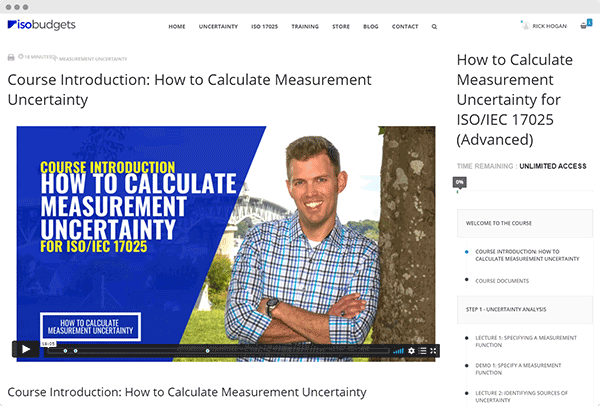
“DISCOVER THE BEST WAY TO ESTIMATE MEASUREMENT UNCERTAINTY AND MEET ISO/IEC 17025:2017 REQUIREMENTS”
(This is the most comprehensive measurement uncertainty training course available.)
“POSSIBLY THE BEST MEASUREMENT UNCERTAINTY TRAINING COURSE FOR CALIBRATION AND TESTING LABS EVER MADE…”
“Finally, a measurement uncertainty training course that teaches you how to prepare for ISO/IEC 17025 accreditation.“
Join This Course Today.
YOU GET ACCESS TO THE FOLLOWING
COURSE CURRICULUM
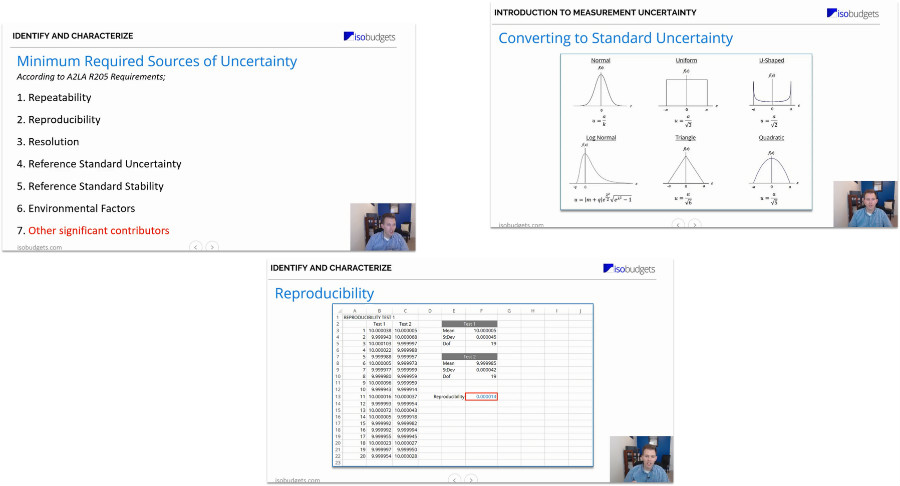
Module 1 – Uncertainty Analysis
Lesson 2: Identify Sources of Uncertainty You will learn how to find sources uncertainty for your uncertainty analysis and which sources you should focus on.
Lesson 3: Quantify Sources of Uncertainty You will learn how to analyze your equipment’s calibration data and Type A data to calculate the value of each source of uncertainty.
Lesson 4: Characterize Sources of Uncertainty You will learn how to pick the right uncertainty type (e.g. Type A or Type B) and probability distributions for your uncertainty components.
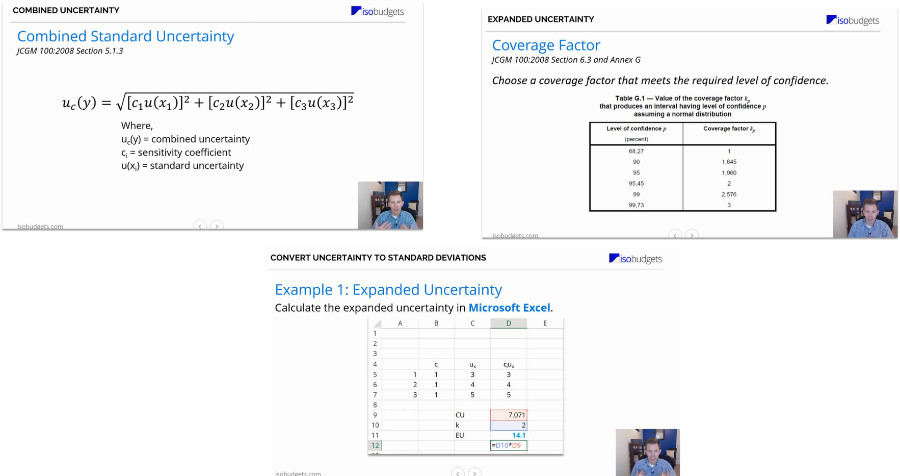
Module 2 – Estimating Uncertainty
Lesson 6: Calculate the Combined Uncertainty You will learn the GUM method for combining uncertainty components.
Lesson 7: Calculate Expanded Uncertainty You will learn how to select expansion factors and calculate expanded uncertainty.
Lesson 8: Evaluate The Expanded Uncertainty You will learn how to evaluate your estimated uncertainty and validate it.
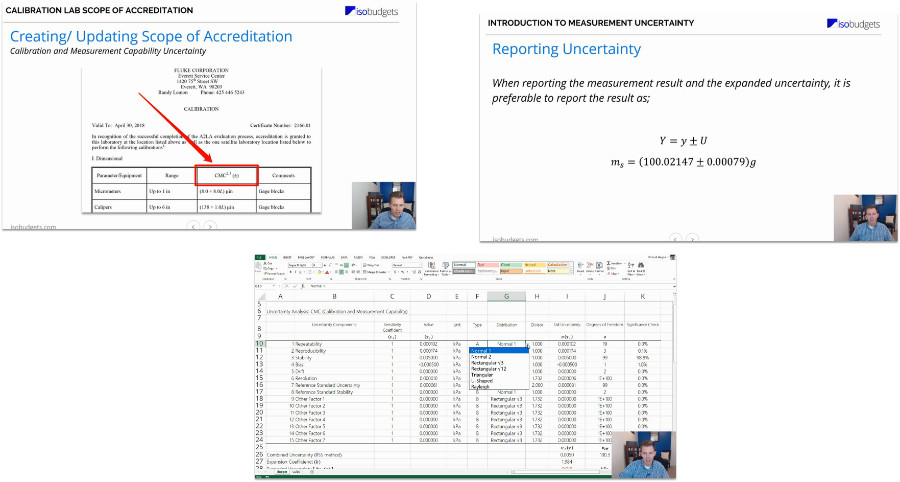
Step 3 – Preparing for ISO/IEC 17025 Accreditation
Lesson 10: Calculate the CMC Uncertainty You will learn to calculate CMC Uncertainty equations for your scope of accreditation.
Lesson 11: Reporting Measurement Uncertainty You will learn how to report uncertainty in your test and calibration certificates.
Lesson 12: Creating and Updating the Scope of Accreditation You will learn how to develop your scope of accreditation for ISO/IEC 17025 accreditation.
Lesson 13: Statements of Conformity and Decision Rules You will learn how other labs are meeting ISO/IEC 17025:2017 requirements with examples. New
Lesson 14: One Factor at a Time Analysis You will learn the #1 secret tactic that I use to quantify sources of uncertainty. New
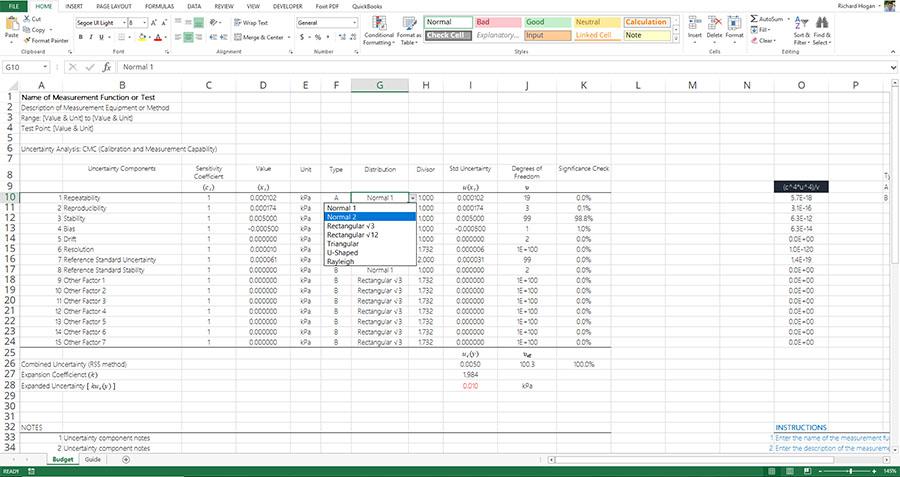
Step 4 – Perform an Uncertainty Analysis
Project 2: Identify Sources of Uncertainty You will learn how to find sources uncertainty for your uncertainty analysis and which sources you should focus on.
Project 3: Quantify Sources of Uncertainty You will learn how to analyze your equipment’s calibration data and Type A data to calculate the value of each source of uncertainty.
Project 4: Characterize Sources of Uncertainty You will learn how to pick the right uncertainty type (e.g. Type A or Type B) and probability distributions for your uncertainty components.
Project 5: Calculate the Combined Uncertainty You will learn the GUM method for combining uncertainty components.
Project 6: Calculate Expanded Uncertainty You will learn how to select expansion factors and calculate expanded uncertainty.
Project 7: Find Significant Contributors to Uncertainty You will learn how to find the most significant contributors to uncertainty.
Project 8: Calculate Effective Degrees of Freedom You will learn how to calculate the effective degrees of freedom using the Welch Satterthwaitte equation.
Project 9: Evaluate The Expanded Uncertainty You will learn how to evaluate your estimated uncertainty and validate it.
“YOU’LL LEARN HOW TO FIND SOURCES OF UNCERTAINTY AND CALCULATE THEIR VALUE TO MAKE PROFESSIONAL UNCERTAINTY BUDGETS”
(Including how to meet the requirements of A2LA R205)
LEARNING OBJECTIVES
Join This Course Today.
“WHY THIS IS THE ONLY UNCERTAINTY TRAINING COURSE OF ITS KIND… AND WHY IT WILL TRANSFORM THE WAY YOU ESTIMATE UNCERTAINTY”
“LEARN THE EXACT SYSTEM I USE TO ESTIMATE UNCERTAINTY AND CREATE PROFESSIONAL UNCERTAINTY BUDGETS”
WHAT INCLUDED IN THIS COURSE

14 Measurement Uncertainty Training Lecture Videos
Lesson 2: Identify Sources of Uncertainty You will learn how to find sources uncertainty for your uncertainty analysis and which sources you should focus on.
Lesson 3: Quantify Sources of Uncertainty You will learn how to analyze your equipment’s calibration data and Type A data to calculate the value of each source of uncertainty.
Lesson 4: Characterize Sources of Uncertainty You will learn how to pick the right uncertainty type (e.g. Type A or Type B) and probability distributions for your uncertainty components.
Lesson 5: Convert Uncertainty To Standard Deviations You will learn how to convert your uncertainty components to standard uncertainty.
Lesson 6: Calculate the Combined Uncertainty You will learn the GUM method for combining uncertainty components.
Lesson 7: Calculate Expanded Uncertainty You will learn how to select expansion factors and calculate expanded uncertainty.
Lesson 8: Evaluate The Expanded Uncertainty You will learn how to evaluate your estimated uncertainty and validate it.
Lesson 9: Create an Uncertainty Budget You will learn how to create an uncertainty budget in Excel that will automatically calculate uncertainty.
Lesson 10: Calculate the CMC Uncertainty You will learn to calculate CMC Uncertainty equations for your scope of accreditation.
Lesson 11: Reporting Measurement Uncertainty You will learn how to report uncertainty in your test and calibration certificates.
Lesson 12: Creating and Updating the Scope of Accreditation You will learn how to develop your scope of accreditation for ISO/IEC 17025 accreditation.
Lesson 13: Statements of Conformity and Decision Rules You will learn how other labs are meeting ISO/IEC 17025:2017 requirements with examples. New
Lesson 14: One Factor at a Time Analysis You will learn the #1 secret tactic that I use to quantify sources of uncertainty. New
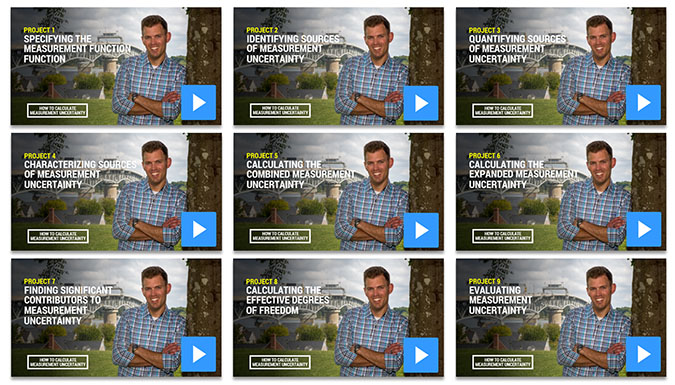
9 Measurement Uncertainty Training Demonstration Videos
Project 2: Identify Sources of Uncertainty You will learn how to find sources uncertainty for your uncertainty analysis and which sources you should focus on.
Project 3: Quantify Sources of Uncertainty You will learn how to analyze your equipment’s calibration data and Type A data to calculate the value of each source of uncertainty.
Project 4: Characterize Sources of Uncertainty You will learn how to pick the right uncertainty type (e.g. Type A or Type B) and probability distributions for your uncertainty components.
Project 5: Calculate the Combined Uncertainty You will learn the GUM method for combining uncertainty components.
Project 6: Calculate Expanded Uncertainty You will learn how to select expansion factors and calculate expanded uncertainty.
Project 7: Find Significant Contributors to Uncertainty You will learn how to find the most significant contributors to uncertainty.
Project 8: Calculate Effective Degrees of Freedom You will learn how to calculate the effective degrees of freedom using the Welch Satterthwaitte equation.
Project 9: Evaluate The Expanded Uncertainty You will learn how to evaluate your estimated uncertainty and validate it.

1 Measurement Uncertainty Calculator for Microsoft Excel
This calculator has the following features:
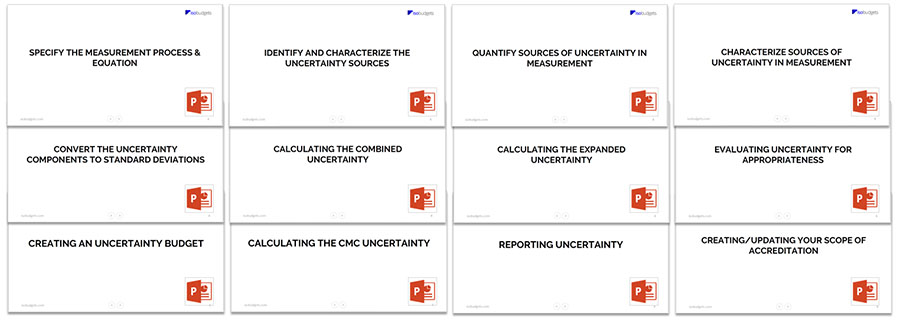
Bonus #1: 14 Measurement Uncertainty Training PowerPoint Slides
Lesson 2: Identify Sources of Uncertainty You will learn how to find sources uncertainty for your uncertainty analysis and which sources you should focus on.
Lesson 3: Quantify Sources of Uncertainty You will learn how to analyze your equipment’s calibration data and Type A data to calculate the value of each source of uncertainty.
Lesson 4: Characterize Sources of Uncertainty You will learn how to pick the right uncertainty type (e.g. Type A or Type B) and probability distributions for your uncertainty components.
Lesson 5: Convert Uncertainty To Standard Deviations You will learn how to convert your uncertainty components to standard uncertainty.
Lesson 6: Calculate the Combined Uncertainty You will learn the GUM method for combining uncertainty components.
Lesson 7: Calculate Expanded Uncertainty You will learn how to select expansion factors and calculate expanded uncertainty.
Lesson 8: Evaluate The Expanded Uncertainty You will learn how to evaluate your estimated uncertainty and validate it.
Lesson 9: Create an Uncertainty Budget You will learn how to create an uncertainty budget in Excel that will automatically calculate uncertainty.
Lesson 10: Calculate the CMC Uncertainty You will learn to calculate CMC Uncertainty equations for your scope of accreditation.
Lesson 11: Reporting Measurement Uncertainty You will learn how to report uncertainty in your test and calibration certificates.
Lesson 12: Creating and Updating the Scope of Accreditation You will learn how to develop your scope of accreditation for ISO/IEC 17025 accreditation.
Lesson 13: Statements of Conformity and Decision Rules You will learn how other labs are meeting ISO/IEC 17025:2017 requirements with examples. New
Lesson 14: One Factor at a Time Analysis You will learn the #1 secret tactic that I use to quantify sources of uncertainty. New
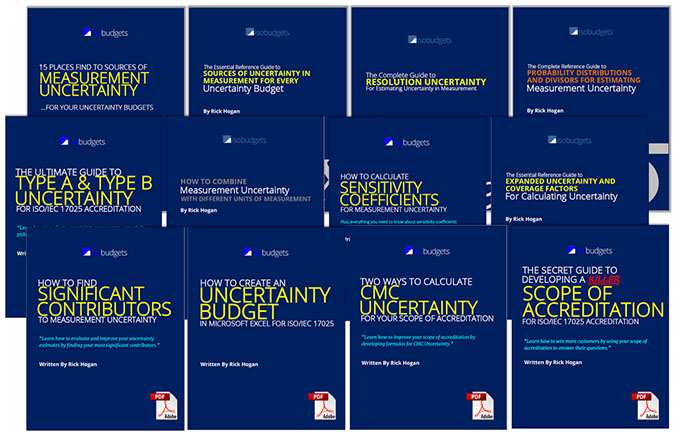
Bonus #2: 12 Measurement Uncertainty Training Guides ($350 value)
Guide 2: 15 Places to Find Sources of Uncertainty in Measurement Guide Learn how to find sources of uncertainty and discover 15 resources you can use to find them quickly.
Guide 3: 8 Sources of Uncertainty for Every Uncertainty Budget Guide Learn how to evaluate and quantify 8 uncertainty sources that I use in every uncertainty budget. This will help you meet A2LA R205 requirements.
Guide 4: Type A & Type B Uncertainty Guide Learn everything you need to know about Type A and Type B uncertainty. This simplifies the GUM descriptions and help you decide whether you should select Type A or Type B uncertainty.
Guide 5: Probability Distributions and Divisors for Estimating Uncertainty Guide Learn the most common probability distributions used in uncertainty analysis. Plus, learn how to pick the right distributions for your analysis and what divisors you should use.
Guide 6: How to Calculate Sensitivity Coefficients Guide Learn all about sensitivity coefficients and how to calculate them for your uncertainty analysis.
Guide 7: How to Calculate Uncertainty with Different Units of Measurement Guide Learn how to use sensitivity coefficients to estimate uncertainty when contributors have different units of measurement.
Guide 8: Expanded Uncertainty and Coverage Factors Guide Learn how to pick an expansion factor and calculate the expanded measurement uncertainty. Plus, learn how to use the Student’s T Table and automate the process.
Guide 9: How to Find Significant Contributors to Measurement Uncertainty GuideLearn how to evaluate and validate your uncertainty budgets. Plus, learn how to find your largest contributors to uncertainty and how it can help you reduce uncertainty.
Guide 10: How to Create an Uncertainty Budget in Microsoft Excel GuideLearn how to make an uncertainty budget calculator in Microsoft Excel from scratch. Learn all of the formulas and functions so you can make your own calculators.
Guide 11: How to Calculate CMC Uncertainty Equations for Your Scope of Accreditation GuideLearn how to calculate CMC Uncertainty equations from your uncertainty analysis results. Then, learn how to use these equations in your scope of accreditation.
Guide 12: How to Develop a Scope of Accreditation GuideLearn how to develop your scope of accreditation for ISO/IEC 17025:2017. This guide includes some great tactics to help you make the perfect scope of accreditation, so customers can find your laboratory.
“MORE THAN 25,000 PEOPLE VISIT ISOBUDGETS.COM EACH MONTH TO LEARN ABOUT MEASUREMENT UNCERTAINTY”

MEET YOUR INSTRUCTOR

HI, I’M RICK HOGAN
I’m an expert at estimating uncertainty. Here’s how I can help you.
I’ve been estimating uncertainty in measurement since 2008. Over the years, I have developed simple and clever ways to calculate measurement uncertainty.
“HERE’S JUST A FRACTION OF THE AMAZING INFORMATION YOU WILL LEARN IN THIS COURSE”
HERE’S WHAT STUDENTS ARE SAYING
 SHANNON HOISETHStudent
SHANNON HOISETHStudentRating:
 BRYCE PAGEStudent
BRYCE PAGEStudentRating:
 AUSTIN BROWNELLStudent
AUSTIN BROWNELLStudentRating:
PLUS, GET YOUR TRAINING CERTIFICATE WHEN YOU COMPLETE THE COURSE
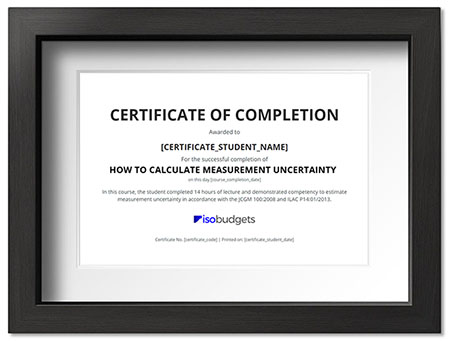
Join This Course Today.

7 DAY, RISK FREE, MONEY BACK GUARANTEE
CANCELLATION & REFUND POLICY
WHAT STUDENTS ARE SAYING
 SHANNON HOISETHStudent
SHANNON HOISETHStudentRating:
 BRYCE PAGEStudent
BRYCE PAGEStudentRating:
 AUSTIN BROWNELLStudent
AUSTIN BROWNELLStudentRating:
FREQUENTLY ASKED QUESTIONS
Who should take this course?
How long do I have access to the course?
What equipment/software will I need to complete the course?
What do I do if I need help?
How long is the course?
Can I pay with PayPal?
Can I pay with a Purchase Order?
Is there a discount for multiple students?
I need to get approval first, will you hold the sale price for me?
What if I am unhappy with the course?
When does the course start and finish?
Can I join the course just to use the videos as a reference?
Can I use this course to train other employees/coworkers?
Can I transfer my course seat to another employee/coworker?
Can I preregister for the course?
Can I repeat the course as many times as I like?
Is this course video on demand or live webinars?
Why don’t you offer these courses all the time?
Why is your course more expensive than other uncertainty courses?
HERE’S WHAT TO DO NEXT
Join The Course Today And Watch Lesson #1 Now.
(If you are not satisfied, you have 7 days to request a full refund)
Learn everything you need to know to:
In step 1, you will learn the fundamental skills and procedures that you need to use each time you perform an uncertainty analysis.
In step 2, you will learn how to estimate uncertainty using the GUM method. Then, I will show you how to automate it with a measurement uncertainty calculator.
In step 3, you will learn how to create uncertainty budgets and a scope of accreditation, so you can apply for ISO/IEC 17025 accreditation.
Before you complete measurement uncertainty training, I want to make sure that you can estimate uncertainty and create uncertainty budgets.
This course is jam-packed full of powerful information that is not taught in any other course. I will show you exactly how to do everything step by step in simple and practical ways. Each process that you will learn works and has actually been used in labs that are ISO/IEC 17025:2017 accredited.
This course has 14 video lectures that will teach you the fundamental skills and procedures that you need to perform when estimating measurement uncertainty.
This course has 9 video demonstrations that will show how I estimate measurement uncertainty step by step. You will learn exactly how to perform each step of the process from beginning to end, including all formula, functions, and tools you need to perform uncertainty analysis.
This course includes 1 measurement uncertainty calculator for Microsoft Excel. This uncertainty calculator is more advanced than any template provided by your accreditation body, and you will learn how to make professional uncertainty budgets that support your scope of accreditation and get your laboratory ISO/IEC 17025:2017 accredited.
Included with this course are the PointPoint Slides for all 12 lecture videos. These are a great asset to save to your computer keep when you want to review the information again in the future or train other personnel in your lab.
Included with this course are 12 measurement uncertainty training guides that will give you step by step procedures to help you estimate uncertainty and prepare for ISO/IEC 17025:2017 accreditation. These are the same guides available on my site in the Training Bundle for $350. Now, they are yours for FREE included with the course.
If you are not sure whether or not you should join this course. Just visit my blog and see all of the great information that I give away for FREE. In fact, I would recommend that you check it out first before joining my course. I want you to see the amount of information that I give away and how easy it is to follow and implement.
“Creating an uncertainty budget from start to finish can be an intimidating challenge. Mr. Hogan has created a systematic, step by step approach that breaks the process down into easier to understand concepts. Each lesson is clear and concise, with excellent examples and tools that walk the student through the process of building an uncertainty budget. I highly recommend the course.”
“This course is accessible to students and thorough. Mr. Hogan explains the calculations well as he walks the students from the introductory concepts of uncertainty to the completion of an uncertainty budget ready for submission for ISO 17025 approval. I greatly appreciated his focus on developing a robust uncertainty budget that was defensible to auditors, and on many occasions pointing out common problem areas that assessors flag. The documentation is first rate and will provide a valuable reference.”
“The course was well taught by Richard, he did a great job of watering down the confusing points to point out what they really are looking for in those sections. The course helped clear up a lot of things for me and I will be strongly recommending to others who are interested. I really enjoyed how this course was taught and how the schedule went. Richard is also very easy to get in touch with to ask any questions.”
“Creating an uncertainty budget from start to finish can be an intimidating challenge. Mr. Hogan has created a systematic, step by step approach that breaks the process down into easier to understand concepts. Each lesson is clear and concise, with excellent examples and tools that walk the student through the process of building an uncertainty budget. I highly recommend the course.”
“This course is accessible to students and thorough. Mr. Hogan explains the calculations well as he walks the students from the introductory concepts of uncertainty to the completion of an uncertainty budget ready for submission for ISO 17025 approval. I greatly appreciated his focus on developing a robust uncertainty budget that was defensible to auditors, and on many occasions pointing out common problem areas that assessors flag. The documentation is first rate and will provide a valuable reference.”
“The course was well taught by Richard, he did a great job of watering down the confusing points to point out what they really are looking for in those sections. The course helped clear up a lot of things for me and I will be strongly recommending to others who are interested. I really enjoyed how this course was taught and how the schedule went. Richard is also very easy to get in touch with to ask any questions.”
*This course is best for estimating uncertainty for physical measurements and not chemical analysis results. If you need help estimating uncertainty for chemical analysis, check this course instead: How to Calculate Uncertainty in Chemical Analysis.
Like I mentioned before, this is the best measurement uncertainty training course available today. No other course will teach you half the information that I am about to give to you. Best of all, if you don’t like the course, let me know within 7 days and I will give you 100% of your money back!